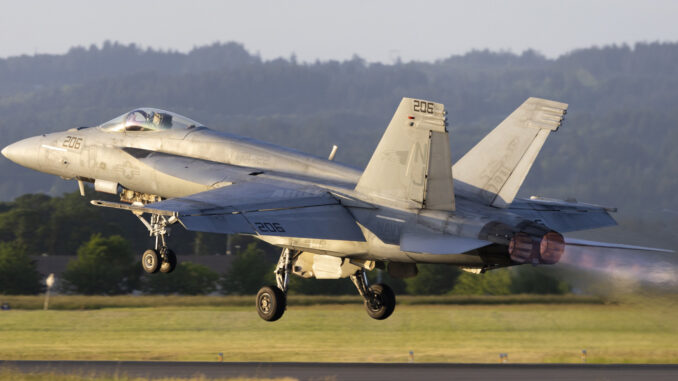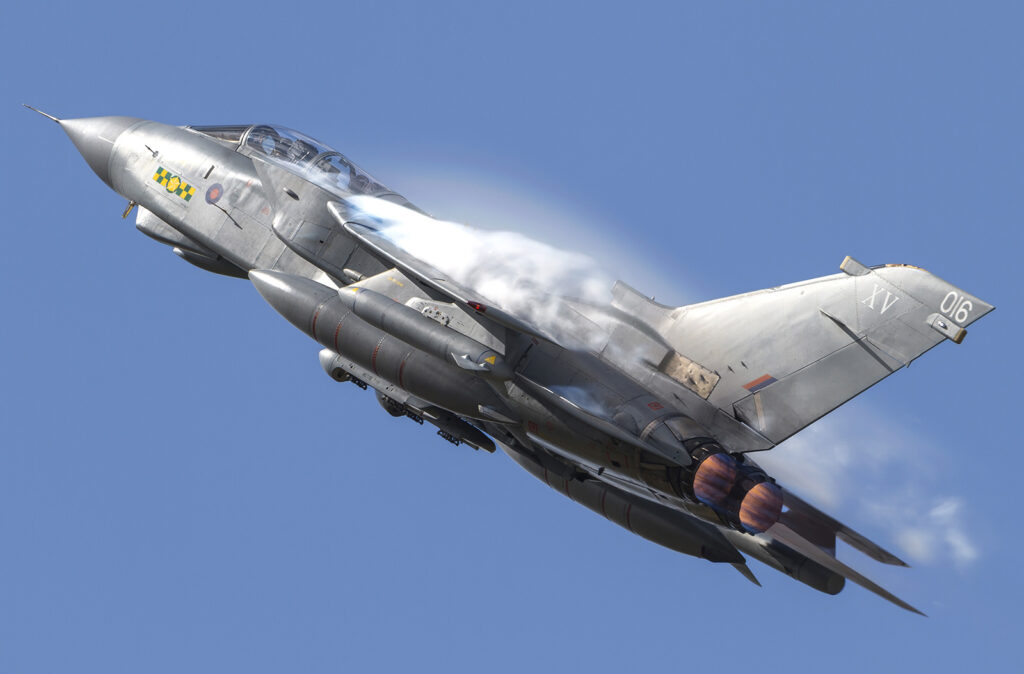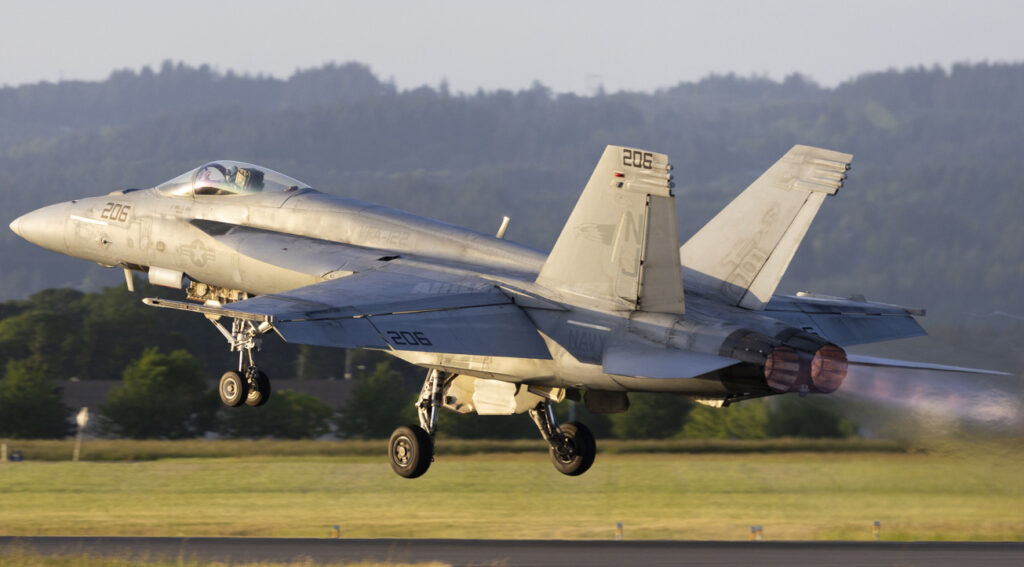
Compare the Panavia Tornado ADV and the Boeing F/A-18 Hornet on technical, scientific and budgetary criteria to determine which excels in modern air defence.
The Panavia Tornado ADV and the Boeing F/A-18 Hornet represent two distinct philosophies in fighter aircraft design and capability. The Tornado ADV, developed by a European consortium, specialises in long-range interception missions, while the F/A-18 Hornet, designed by Boeing, is a multi-role aircraft used by several air forces around the world.

Technical Description of the Panavia Tornado ADV
The Panavia Tornado ADV (Air Defense Variant) is an interceptor designed for long-range air defense missions. Developed by a consortium of three European countries (United Kingdom, Germany and Italy), it is equipped with two Turbo-Union RB199-34R Mk 104 turbojet engines, offering a total thrust of 162 kN with afterburner. The Tornado ADV can reach a maximum speed of Mach 2.2 (2337 km/h) and has a range of 1853 km. It is armed with a 27 mm Mauser cannon and can carry up to 5806 kg of ammunition, including medium- and short-range air-to-air missiles. However, its heavy weight and high maintenance costs have often been criticised.
Technical Description of the Boeing F/A-18 Hornet
The Boeing F/A-18 Hornet is an American multi-role fighter aircraft used by the US Navy and the US Marine Corps. Powered by two General Electric F404-GE-402 turbojet engines, it offers a total thrust of 160 kN with afterburner. The F/A-18 can reach a maximum speed of Mach 1.8 (1915 km/h) and has a range of 2346 km. It is equipped with two 20 mm M61 Vulcan cannons and can carry up to 7,700 kg of ammunition, including air-to-air and air-to-surface missiles and guided bombs. Its versatile design and ability to operate from aircraft carriers make it a major asset for naval operations.
Technical Criteria
Maximum take-off weight
Definition: The maximum take-off weight (MTOW) represents the maximum total weight that the aircraft can support at take-off, including fuel, armament and payload. It is a key indicator of the aircraft’s load capacity.
Weight: This criterion is crucial because it determines the amount of fuel and weapons the aircraft can carry, directly influencing its endurance and combat capability.
Comparison:
- Panavia Tornado ADV:** 27,986 kg.
- Boeing F/A-18 Hornet:** 23,400 kg.
Analysis: The Tornado ADV has a higher maximum take-off weight, allowing it to carry more fuel and weapons.
Conclusion: Point for the Tornado ADV.
Range
Definition: The range is the maximum distance an aircraft can cover without refuelling.
Importance: A greater range allows the aircraft to cover larger areas without the need for in-flight refuelling, increasing its operational efficiency.
Comparison:
- Panavia Tornado ADV:** 1853 km.
- Boeing F/A-18 Hornet:** 2346 km.
Analysis: The F/A-18 Hornet has a superior range, enabling it to operate over longer distances without refuelling.
Conclusion: Point for the F/A-18 Hornet.
Maximum Speed
Definition: Maximum speed is the highest speed an aircraft can reach in flight.
Importance: A high maximum speed allows the aircraft to quickly intercept targets and evade threats.
Comparison:
- Panavia Tornado ADV:** Mach 2.2 (2337 km/h).
- Boeing F/A-18 Hornet:** Mach 1.8 (1915 km/h).
Analysis: The Tornado ADV is faster than the F/A-18 Hornet, giving it an advantage in terms of rapid interception.
Conclusion: Point for the Tornado ADV.
Operational Ceiling
Definition: The operational ceiling is the maximum altitude at which an aircraft can fly effectively.
Importance: A higher operational ceiling allows the aircraft to operate above the range of most enemy air defence systems.
Comparison:
- Panavia Tornado ADV:** 15 240 m.
- Boeing F/A-18 Hornet:** 15,000 m.
Analysis: The Tornado ADV has a slight advantage in terms of operational ceiling, although the difference is marginal.
Conclusion: Point for the Tornado ADV.
Manoeuvrability
Definition: Manoeuvrability is the ability of an aircraft to change direction and altitude quickly and accurately.
Importance: Good manoeuvrability is essential for close air combat and for avoiding enemy attacks.
Comparison:
- Panavia Tornado ADV:** Designed primarily for high-speed interception, it is less manoeuvrable in close combat.
- Boeing F/A-18 Hornet:** Known for its high manoeuvrability thanks to its advanced flight controls and multi-role design.
Analysis: The F/A-18 Hornet is superior in terms of manoeuvrability, being designed to excel in close air combat.
Conclusion: Points for the F/A-18 Hornet.
Weapon Carrying Capability
Definition: Weapons carrying capacity is the type and quantity of weapons that the aircraft can carry.
Importance: A greater payload capacity allows the aircraft to carry out a variety of missions with a larger payload.
Comparison:
- Panavia Tornado ADV:** Up to 5806 kg of ammunition, including medium- and short-range air-to-air missiles.
- Boeing F/A-18 Hornet:** Up to 7,700 kg of ammunition, including air-to-air missiles, air-to-surface missiles and guided bombs.
Analysis: The F/A-18 Hornet has a superior weapons-carrying capacity, offering greater flexibility and firepower.
Conclusion: Point for the F/A-18 Hornet.

Looking at the technical criteria, the Boeing F/A-18 Hornet stands out for its range, manoeuvrability and weapons-carrying capacity, making it more versatile and suitable for a wider range of missions. The Panavia Tornado ADV excels in maximum speed and operational ceiling, but its advantages are more specific to high-speed interception missions. So, for versatility and multi-role capability, the F/A-18 Hornet is the superior choice.
Best aircraft based on technical criteria: Boeing F/A-18 Hornet.
War Wings Daily is an independant magazine.